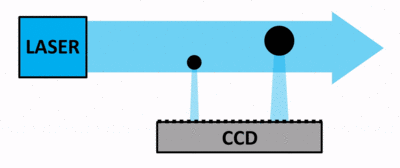

The instrument characterizes nanoparticles by analyzing their thermal-induced motion (Brownian motion) and larger, micron-sized particles by analyzing gravitational settling. The optical system includes innovative multispectral illumination and detection techniques that enable video recording of scattered light from wide-ranging sizes of individual particles simultaneously.
The obtained video shows each individual nanoparticle. By taking advantage of modern high resolution video cameras and computer graphics processing speed, the motion of each particle is tracked to determine the diffusion coefficient, and, from that, the size of each particle. Since data from each particle is obtained, the particle size distribution from a mixture is readily discerned as shown to the right.

Its ability to work with the very large dynamic range of scattered light intensity produced by differently-sized nanoparticles coexisting in a polydisperse sample. This technical feat is accomplished by combining clever software with advanced optics and multiple light sources. The ViewSizer™ 3000 technology from HORIBA Instruments is an elegant and absolute method that does not require calibration standards or knowledge of particle material properties such as refractive index.

Test results from other light scattering techniques typically have significant artifacts and uncertainties as a result of this massively disproportionate scattered light intensity. The issue being, very high intensities of scattered light from larger particles overwhelm the typical detection systems and obscure the analysis of other particles coexisting in the sample.
Plurality of light beams at different spectral wavebands is used to create one light sheet for illuminating nanoparticles in a liquid sample.
A detector is configured to capture images of light scattered by nanoparticles. Images are recorded over time to form videos.
The videos are analyzed to compute Brownian diffusion coefficient for each tracked nanoparticle and, finally, calculate their diameter. Combined data reveal nanoparticle distribution across predetermined set of size bins.
For addressing this huge range of scattered light intensity includes:
With these innovations, the ViewSizer divides the previously unmanageable dynamic range of scattered light intensity from sub-micron particles into discrete and manageable segments. With the ViewSizer, customers are able to visualize nanoparticles and measure particle size distribution for nanoparticle samples containing a wide range of particle sizes. This capability also provides additional benefits, such as measuring particle kinetic processes.
The ViewSizer’s proprietary multispectral illumination and detection enables unique capabilities in the field of fluorescent particle analysis. Now for the first time, customers can enumerate different constituents in the same sample under the same size distribution. The overlapped PSDs in the graph show how the ViewSizer can determine the concentration of each of the three constituents and their percentages of the total mixture. Imagine the possibilities – it’s like flow cytometry for nanoparticles.
Visualize a wide range of nanoparticle sizes simultaneously. This unique capability, enables various benefits including accurate measurement of nanoparticle size distribution and nanoparticle kinetic processes with one easy-to-perform test on particles in liquids.
In most applications it is important to produce nanoparticles within a certain range of sizes. If the measurement technique is not able to provide accurate particle size distributions, you cannot manage your processes to make more of the desired particles and less of the out of spec particles. Similarly it’s hard to optimize process yields if you cannot measure particle concentrations. And if you want to know about particle kinetic processes you’ll need accurate PSD measurements and / or particle visualization over time. These needs are important across the full range of nanoparticle commercialization efforts – from R&D to manufacturing.
Do you have any questions or requests? Use this form to contact our specialists.
Simultaneous Multi-Laser Nanoparticle Tracking Analysis (NTA)